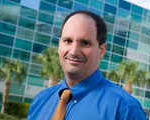Mayo Clinic researchers determine that protein in blood may predict stroke prognosis, recovery
Researchers at Mayo Clinic in Florida and collaborators have found that a biomarker in the blood may determine the extent of brain injury from different types of strokes and predict prognosis in these patients. Their findings are reported in Science Translational Medicine.
The blood biomarker is a protein known as neurofilament light (NFL). The protein is abundant in neurons found in the brain. When neurons are injured following a stroke or from other neurological diseases, NFL is released into cerebrospinal fluid that bathes the brain and then into the blood. The amount of NFL released is indicative of neuron injury in the brain, according to the research team. Stroke is a leading cause of death, but symptoms vary widely from temporary and nondisabling, to severe, long-term impairment.
 “Estimating the severity of a stroke and how well a person is expected to recover is important to patients and their loved ones,” says Tania Gendron, Ph.D. (NSCI ’09), Department of Neuroscience at Mayo Clinic in Florida and first author of the paper.
“Estimating the severity of a stroke and how well a person is expected to recover is important to patients and their loved ones,” says Tania Gendron, Ph.D. (NSCI ’09), Department of Neuroscience at Mayo Clinic in Florida and first author of the paper.
“Reliably predicting a patient’s prognosis is also important to their care, as it informs treatment and rehabilitation decisions. We sought to determine whether the amount of NFL in patients’ blood could be used to predict their prognosis after a stroke — be it an ischemic stroke, which occurs when blood flow to the brain is blocked by a clot, or a hemorrhagic stroke, which occurs when a weak blood vessel bursts and bleeds into the brain.”
 The retrospective study involved participants who enrolled in, and donated blood for, the Mayo Clinic in Florida Familial Cerebrovascular Diseases Registry directed by James Meschia, M.D. (N ’97), chair, Department of Neurology at Mayo Clinic in Florida. Researchers used an investigative blood test to measure NFL concentrations in blood collected from 314 patients following a stroke and in blood from 79 healthy individuals. This allowed them to determine whether NFL is elevated after a stroke. They also examined whether NFL levels are indicative of stroke severity and eventual recovery. To do so, the researchers examined correlations between NFL levels and the degree of brain injury, in addition to neurological, functional or cognitive status of patients at the time their blood was collected. The study also examined whether NFL levels could anticipate future recovery by reliably predicting post-stroke outcomes and survival. To verify their findings, the researchers used a similar approach to evaluate NFL as a prognostic biomarker in two additional groups of stroke patients.
The retrospective study involved participants who enrolled in, and donated blood for, the Mayo Clinic in Florida Familial Cerebrovascular Diseases Registry directed by James Meschia, M.D. (N ’97), chair, Department of Neurology at Mayo Clinic in Florida. Researchers used an investigative blood test to measure NFL concentrations in blood collected from 314 patients following a stroke and in blood from 79 healthy individuals. This allowed them to determine whether NFL is elevated after a stroke. They also examined whether NFL levels are indicative of stroke severity and eventual recovery. To do so, the researchers examined correlations between NFL levels and the degree of brain injury, in addition to neurological, functional or cognitive status of patients at the time their blood was collected. The study also examined whether NFL levels could anticipate future recovery by reliably predicting post-stroke outcomes and survival. To verify their findings, the researchers used a similar approach to evaluate NFL as a prognostic biomarker in two additional groups of stroke patients.
The blood samples and clinical information were provided by clinical research authors on the paper from Mayo Clinic, University of Pennsylvania, Yale University, Massachusetts General Hospital and Washington University.
 “We discovered that blood levels of NFL do predict stroke severity,” says Leonard Petrucelli, Ph.D. (NSCI ’03), Department of Neuroscience at Mayo Clinic in Florida and one of the senior authors on the paper. “We found that higher NFL levels forecast worse functional outcomes and shorter survival time after a stroke. We found this to be the case for ischemic stroke and hemorrhagic strokes. Our study establishes NFL as a promising prognostic biomarker for stroke.” Dr. Petrucelli is the Ralph B. and Ruth K. Abrams Professor of Neuroscience.
“We discovered that blood levels of NFL do predict stroke severity,” says Leonard Petrucelli, Ph.D. (NSCI ’03), Department of Neuroscience at Mayo Clinic in Florida and one of the senior authors on the paper. “We found that higher NFL levels forecast worse functional outcomes and shorter survival time after a stroke. We found this to be the case for ischemic stroke and hemorrhagic strokes. Our study establishes NFL as a promising prognostic biomarker for stroke.” Dr. Petrucelli is the Ralph B. and Ruth K. Abrams Professor of Neuroscience.
Currently, brain imaging is used to determine damage from a stroke. While a blood test for NFL is not yet available in the clinical setting, researchers hope that in the future, physicians may be able to decrease use of imaging — using instead an NFL blood test to better determine the best course of treatment — as well as boost clinical trials with better matched groups of patients based on degree of brain injury and severity of symptoms.
“We are hopeful that our findings will ultimately change how patients are treated by using NFL biomarkers in clinical trials to allow for more rapid and reliable detection of therapeutic effects,” says Dr. Meschia. “Our findings may also help us better plan rehabilitation needs for patients who need it most and for longer term.”
This research was funded by the National Institutes of Health, Mayo Clinic, and the Donald G. and Jodi P. Heeringa family.